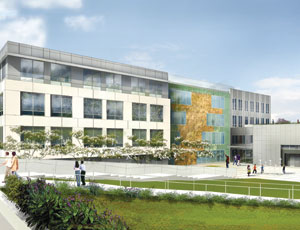The timely creation of a new, environmentally-educational 67,000 sq ft “living room” for the young city of Shoreline was the result of a public-partnership that welcomed citizens in the process.

The timely creation of a new, environmentally - educational 67,000 sq ft “living room” for the young city of Shoreline was the result of a public-partnership that welcomed citizens in the process.
The city saved its tax pennies since incorporating a dozen years ago to buy land and put a $10 million downpayment on construction of a new City Hall and Civic Center. Development partner Opus Northwest, which was chosen from a field of six bidders, used the city’s strong credit rating to secure a low-interest loan for the balance of the $33 million project, even in the difficult credit climate of 2007.
“No new taxes will be needed to fund the project and debt was kept to a minimum,” said City Manager Bob Olander. General fund monies previously used to pay rent on the old city hall facilities and a portion of the Real Estate Excise Taxes (REET) will be used to make the annual debt service payments on the bonds.
Shoreline Project Manager Jesus Sanchez praised the combination of the design-build, build-to-suit/lease-to-own methods for limiting the city’s exposure to cost overruns. “One of the main things Opus brought to the table was collaboration,” says Sanchez.
One example of the benefit of design team flexibility was a quick change orchestrated after steel prices spiked 30% in 2008. Opus worked with the city and the architect to switch from a steel frame to post-tension concrete to save money while realizing the same structural benefits.
“Our role is to act as a conductor, making sure that every group’s needs are met – the city, the developer, residents and the planet’s needs,” said PJ Santos, senior real estate developer for Opus Northwest. “That requires an open approach.”
That open approach included bringing the public in for hands-on workshops early in the process. Foam models of the building’s components were made available for citizens to move on the footprint while voicing their priorities for how the 2.7-acre space will be used.
“Public input was an important part of the final orientation, look and feel of the project,” said Eric Norhdurft, project manager for architect LMN.
One change that came out of these meetings was the inclusion of a parking structure to minimize the car footprint and maximize the green space.
Though City Hall is the base of government operations, the building also includes space for community activities. Conference facilities, water features and an outdoor grass amphitheater give the city a central place to gather. Connections to the Interurban Trail and mass transit along with electric car charging stations, make getting to the site easier.
The design includes a one-of-a-kind flowering dogwood tree treatment on the building’s inner courtyard wall by northwest artist Linda Beaumont. Suspended from the ceiling in the lobby of City Hall are 14 “clouds” designed by artist Leo Saul Berk that represent the 14 neighborhoods in Shoreline.
Built to high sustainability and LEED silver standards, the project is meant to embody and teach environmental best practices. The building is home to a demonstration 1,600 sq ft green roof, pervious concrete and solar photovoltaic-powered exterior garbage compacters.
The green touches cut the building’s greenhouse gas footprint and operating costs. Solar shades on the West and South facades keep the building cooler on sunny days and conserve energy by relieving the burden on cooling systems. Solar systems will reduce the use of electricity for hot water by approximately 34%. Low-flow toilets, urinals, showerheads, and automatic sensor-controlled lavatory faucets reduce water use is reduced by approximately 43%.
Signage and interactive touch-screen kiosks make the building an environmental educational experience.
Phase one construction was complete in August. The adjacent parking garage and amphitheater is scheduled for completion in December.
All Together
A Public-Private Partnership with Wright Runstad & Co. will consolidate state IT operations
Washington State Dept. of Information Services (DIS) leaders joined with Wright Runstad & Company, Seattle, and contractors on backhoe excavators in August to kick off a $255 million construction project that could eventually consolidate 900 employees in a central data center campus near the state capitol in Olympia.
“The project will make this agency more efficient,” said DIS Director Tony Tortorice.
The state’s existing 35-year-old data center was out of space and power capacity. Employees were housed in leased buildings miles away. After a number of iterations, the solution drawn was a pair of linked buildings totaling 302,800 sq ft. A 130,000 sq ft office building and 172,800 sq ft data center will include 30,000 sq ft left unfinished to provide for growth. An adjacent parking garage and bike trail connection will provide access.
DIS partnered with Seattle-based Wright Runstad & Company to lock-in a maximum lease price based on market rates that would result in the most efficient project possible without the risk of cost overruns.
“This arrangement meant we didn’t have to take $300 million out of our pocket in tough economic times,” said Joanne Todd, DIS communications director. “It also allowed us to move ahead quickly.”
As an IT center, communications and technology equipment flexibility and redundancy was a major focus of the design. The data center will include raised floors and highly-sensitive, automatic climate controls. The centralized site will also better meet Homeland Security and seismic security standards.
The project was designed to be environmentally friendly from start to finish with at least LEED silver certification required. This applied to the inside and outside of the project. At the start, Wright Runstad & Company designers identified several red oak trees that can be saved by uprooting them and replacing them in the project after construction.
“This is a huge opportunity,” Wright Runstad & Company Senior Vice President and Director of Development Cindy Edens said in a press release. “Mature trees like these are impossible to find and place on a site. This gives the landscaping much greater depth with the combination of new and mature trees.”
The green construction techniques include recycling 67 percent of the 1,754 tons of material that has been removed from the site.
The project represents the first major construction on the Capitol Campus in two decades and is scheduled to be complete in fall, 2011.
Construction Team:Owner:
Developer:
Construction manager:
Architect:
Landscaping design:
Structural engineering:
LEED consultant:
Soils engineering:
Environmental consulting:
Plumbing and HVAC:
Electrical:
Project Team:
Developer:
General Contractor:
Architect:
Structural Engineer:
Civil Engineer:
Mechanical Design-Build:
Electrical Contractor (data center):
Electrical Contractor (office building): Shoreline City Hall/Civic Center Project Team City of Shoreline Opus Northwest, L.L.C., Bellevue, Wash. Opus Northwest Contractors, L.L.C., Bellevue, Wash. LMN, Seattle Karen Kiest Landscape Architects, Seattle CKC Structural Engineers of Minnetonka, Minn. ArchEcology, Seattle Terra Associates, Kirkland, Wash. URS Corp., Seattle MacDonald Miller, Seattle Valley Electric, Seattle Owner: Washington State Department of Information Services Wright Runstad & Company, Seattle, Wash. Howard S. Wright Constructors, Seattle NBBJ, Seattle, Wash. KPFF, Inc., Seattle, Wash. office Parametrix, Auburn, Wash. University Mechanical Contractors, Inc., Mukilteo, Wash. EC Company, Auburn, Wash. Sequoyah Electric, LLC, Redmond, Wash.


Post a comment to this article
Report Abusive Comment